Índice
1. Introduction to Diapering Choices
When it comes to parenting, the decision of selecting the right diaper for your baby is a pivotal one. With an array of choices available in the market, understanding the nuances of each option becomes crucial.
1.1 Overview of Diaper Options
The diaper market offers a spectrum of options, including traditional disposable diapers, eco-friendly biodegradable disposables, and various types of washable cloth diapers. Each type comes with its unique set of features, pros, and cons, catering to different priorities such as convenience, environmental impact, cost, and baby’s comfort.
1.2 Importance of Choosing the Right Type
Selecting the appropriate diaper type is not just a matter of personal preference but also a decision that impacts your baby’s health and comfort. Factors such as skin sensitivity, lifestyle, environmental consciousness, and budget play a significant role in this decision-making process.
2. The Evolution of Diapers
The journey of diaper development is a fascinating one, marked by significant changes and technological advancements. This section traverses through the history of diapering, highlighting the innovations that have led to the modern diapers we use today.
2.1 History of Diapering
From the use of cloth and animal skins in ancient times to the introduction of disposable diapers in the 20th century, the history of diapering reflects a constant pursuit of convenience and efficiency. This evolution mirrors broader social and technological changes throughout history.
2.2 Technological Advancements
Recent years have seen groundbreaking innovations in diaper design and materials. The development of super-absorbent polymers, breathable fabrics, and eco-friendly materials are some of the technological leaps that have transformed diapering, making it safer and more comfortable for babies.
3. Understanding Disposable Diapers
Disposable diapers, preferred by many for their convenience, have their own set of characteristics and considerations. This section delves into the composition and design of disposable diapers and discusses the factors contributing to their widespread use.
3.1 Composition and Design
Disposable diapers are a complex assembly of materials like super-absorbent polymers, nonwoven fabric, and elastic. Understanding these components helps in assessing their functionality and impact on the baby’s health and the environment.
3.2 Convenience Factors
The popularity of disposable diapers can be attributed to their ease of use, leak protection, and availability. This convenience, however, comes with environmental and cost considerations that need to be weighed.
4. Environmental Implications of Disposable Diapers
A significant concern with disposable diapers is their environmental impact. They contribute substantially to landfill waste, with a single diaper taking up to 500 years to decompose. Additionally, the production and disposal of disposable diapers generate a considerable carbon footprint, raising concerns about their long-term ecological implications.
4.1 Landfill Contributions and Longevity
Disposable diapers are a major contributor to landfill waste. The non-biodegradable materials used in these diapers mean they occupy landfill space for centuries. This prolonged decomposition process poses a serious environmental challenge, highlighting the need for more sustainable diapering solutions.
4.2 Carbon Footprint and Resource Usage
The production and disposal of disposable diapers are resource-intensive, involving the consumption of wood pulp, plastics, and energy. The carbon footprint associated with these processes is significant, contributing to greenhouse gas emissions and global climate change. This environmental cost is an important consideration for environmentally conscious parents.
5. Exploring Washable Diapers
Washable diapers, available in various styles and materials like cotton, bamboo, and hemp, offer a reusable alternative to disposables. These diapers require proper laundering, which involves a learning curve but can become a straightforward part of a family’s routine. The choice of washable diapers reflects a commitment to sustainability and can also be gentler on a baby’s skin.
5.1 Varieties and Material Choices
The range of washable diapers includes pre-folds, fitted, pocket, and all-in-one styles, each offering different benefits. Materials such as organic cotton, hemp and bamboo are prized not only for their sustainability but also for their gentleness on sensitive skin, thereby diminishing the likelihood of diaper rash and allergic reactions.
5.2 Maintenance and Laundering
While washable diapers demand more effort in terms of maintenance, modern washing machines and eco-friendly detergents have made this task more manageable. Proper care extends the life of these diapers and ensures they remain hygienic and comfortable for the baby.
6. Eco-Friendliness of Washable Diapers
The sustainability of washable diapers is one of their primary advantages. By reusing diapers, families significantly reduce landfill waste and the environmental toll of manufacturing and transporting disposables. The long-term environmental benefits of washable diapers, especially when used for multiple children, are substantial.
6.1 Reducing Waste and Preserving Resources
Using washable diapers drastically cuts down on the amount of waste sent to landfills. By opting for reusable diapers, families play a direct role in conserving natural resources and reducing environmental degradation.
6.2 Energy and Water Usage
Although washable diapers require water and energy for laundering, the overall environmental impact is often less than that of producing and disposing of disposable diapers. Strategic laundering practices, such as washing full loads and using energy-efficient machines, can further minimize this impact.
7. Cost Analysis: Disposable vs. Washable
Evaluating the cost is crucial when torn between the choice of disposable and washable diapers. This analysis delves deep into both the immediate and sustained financial aspects of these options, providing parents with a clear perspective to align their diapering decision with their budget and lifestyle preferences.
7.1 Initial Investment and Ongoing Costs
Disposable diapers, though convenient, do not necessitate an initial investment, yet their continued use accumulates substantial costs over time. Conversely, washable diapers demand a significant upfront investment. However, this can prove to be cost-effective over the long haul, particularly when the diapers are reused for additional children or resold.
7.2 Long-Term Financial Implications
Diapering a child is a long-term commitment, and the associated costs are noteworthy. In this section, the enduring financial ramifications of choosing disposable diapers over washable ones are thoroughly examined. Key considerations include the average period a child is in diapers and the potential resale value of cloth diapers, offering a comprehensive view of the long-term economic impact of both options.
8. Health and Comfort Considerations
When selecting the ideal diaper, the paramount concern is always the health and comfort of the infant. This crucial segment of the article explores the effects of both disposable and washable diapers on a baby’s skin health, specifically focusing on issues like skin sensitivity and overall comfort.
8.1 Skin Sensitivity and Allergies
The material of the diaper is a vital factor for infants who have sensitive skin or are prone to allergies. This subsection delves into the hypoallergenic qualities of different diaper materials, underlining the importance of finding a balance between effective absorbency and the gentleness required to protect delicate skin. It compares the commonly used materials in both disposable and cloth diapers, assessing their potential to cause irritation or allergic reactions in sensitive infants.
8.2 Comfort for the Baby
A diaper’s purpose extends beyond just functional containment; it plays a vital role to ensure a baby’s comfort. This part of the article examines the ergonomic design and the softness of the materials used in various types of diapers. It emphasizes how these factors are integral to a baby’s comfort, affecting not just skin health but also their freedom of movement. From the snugness of the fit to the breathability of the fabric, every aspect of diaper design that contributes to making the baby feel comfortable and unrestricted is scrutinized here.
9. Lifestyle and Practicality
The decision surrounding diaper choice is deeply intertwined with the lifestyle and practical realities of a family. This section thoughtfully considers how diapering fits into the diverse and dynamic routines of modern families, emphasizing that the choice extends beyond mere preference and delves into the realm of practicality and lifestyle alignment.
9.1 Time and Convenience Factors
For numerous parents, the balance between disposable and washable diapers is swayed significantly by their daily schedules and time constraints. This subsection delves into the time commitment required by each diapering option and assesses their convenience. It offers a detailed analysis of how each type can be integrated into different family routines, taking into account the busy lives of modern parents.
The discussion here will cover aspects such as the ease of changing and disposing of diapers, the time needed for washing and drying cloth diapers, and how these factors might influence a parent’s choice based on their daily commitments and availability.
9.2 Suitability for Different Lifestyles
Recognizing that each family’s daily life is distinct, this part of the article explores the adaptability of different diapering methods to various lifestyles. Whether it’s for working parents who prioritize convenience and time-saving options or stay-at-home caregivers who lean towards more sustainable and cost-effective choices, this section provides insights into how each diapering option aligns with specific lifestyles.
It not only considers the primary caregiver’s routine but also takes into account other factors like availability of laundry facilities, frequency of travel, and environmental consciousness, offering a comprehensive view of how diaper choices can be optimized according to individual family needs and circumstances.
10. Making an Informed Decision
Embarking on the journey to select the most suitable diaper for a child is a task that encompasses a variety of considerations. This critical segment of the article is dedicated to guiding parents through this decision-making process. It ensures that the choice made is not only well-informed but also aligns perfectly with the unique needs and values of the family. This comprehensive guide delves into the multifaceted aspects of diapering, providing clarity and direction in a landscape filled with diverse options.
10.1 Factors to Consider
When it comes to deciding on the right diaper, the factors at play are manifold. This subsection serves as a navigational tool, mapping out the key considerations that should influence the decision. It addresses the environmental impact of different diaper types, which is an increasingly significant concern for many families. Budget constraints are also a major consideration, as the cost of diapering can vary greatly between disposables and reusables.
Furthermore, the child’s health and comfort are paramount, necessitating a close look at the materials and design of the diapers. This roadmap aims to assist parents in considering all these aspects – environmental, financial, and health-related – to make a choice that not only meets the child’s needs but also fits within the family’s environmental ethos and financial framework.
10.2 Tips for Choosing the Right Option for Your Family
Selecting the appropriate diaper transcends basic functionality; it’s a decision deeply rooted in personal family values and lifestyle. This section provides practical tips and actionable advice to empower parents in this selection process. It emphasizes the importance of understanding the child’s specific needs, such as skin sensitivity or comfort preferences and aligning these with the family’s daily routine and environmental beliefs.
The advice given here is tailored to help parents weigh the pros and cons of each option, from the ease of use of disposables to the environmental and financial benefits of washable diapers. By offering these insights, the article aims to provide parents with the knowledge and confidence required to choose a diapering solution that is not just practical and effective but also in sync with their family’s values and way of life.
11. Conclusion: Balancing Needs and Values
In conclusion, this article synthesizes the diverse considerations involved in choosing the right diaper, underscoring the need for a balanced and thoughtful approach. It recognizes that diapering is not just a routine parental task but a decision that intertwines with a family’s needs, environmental values, and financial circumstances. This closing section aims to encourage parents to make choices that embody a harmony of these aspects, reflecting a conscious alignment with their family’s overall well-being and beliefs.

